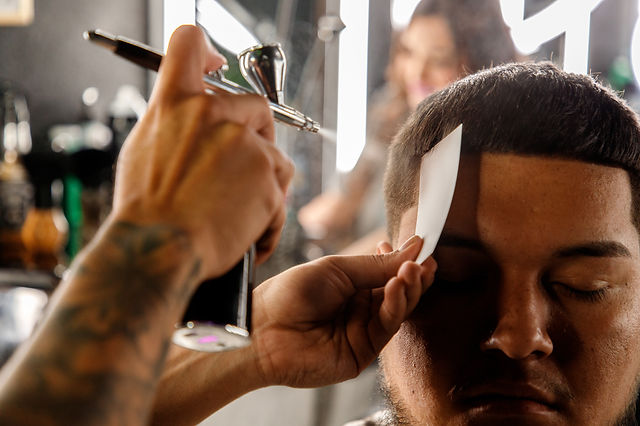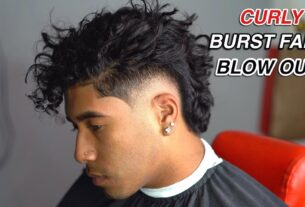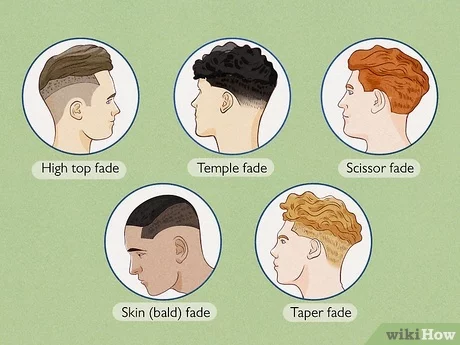Step into the world of barbershops, where the symphony of clippers hums through the air and the aroma of aftershave fills the room.
From pompadours to fades, and buzz cuts to undercuts, this list of barber terms will unveil the secret language and fascinating techniques behind the art of hairstyling.
Prepare to be dazzled by the diverse range of styles and products that play a pivotal role in creating the perfect coiffure.
So grab your comb, sit back, and dive into the world of barbering like never before.
barber terms
Barber terms refer to the specific terminology used in the barbering industry.
These terms help barbers communicate effectively with their clients and understand their desired haircut styles.
Some common barber terms include grade, cuts, fades, tapers, hard part, fringe/bangs, sideburns, arch, neckline shape, and many more.
These terms are vital for barbers to provide the desired haircut and style for their clients, ensuring a satisfactory experience.
Key Points:
- Barber terms are specific terminology used in the barbering industry.
- They help barbers effectively communicate with clients and understand their desired haircut styles.
- Some common barber terms include:
- Grade
- Cuts
- Fades
- Tapers
- Hard part
- Fringe/bangs
- Sideburns
- Arch
- Neckline shape
- And more
- These terms are essential for barbers to provide the desired haircut and style for clients.
- Barber terms ensure a satisfactory experience for clients.
- Understanding barber terms is crucial for effective communication and achieving the desired haircut.
barber terms – Watch Video
💡
Pro Tips:
1. A “strop” is a long strip of leather or canvas that barbers use to sharpen their straight razors. By running the blade back and forth against the strop, they can maintain a sharp and precise edge.
2. The term “tonsure” refers to the practice of shaving the crown of a person’s head, typically performed by monks or religious individuals as a symbol of devotion or religious commitment.
3. In the world of barbers, a “razor burn” is a common term used to describe the irritating red rash that can occur on the skin after a close shave. It’s often caused by friction and improper shaving techniques.
4. The expression “close shave” actually originated from the practice of barbers using a straight razor to shave clients. If a barber made a mistake or cut a customer, it was referred to as a “close shave” because it narrowly avoided being a serious injury.
5. The term “pomade” refers to a hairstyling product commonly used by barbers that provides hold and shine. Interestingly, pomade comes from the French word “pommade,” which originally referred to ointments made from apples (pommes) and was later adopted to describe hair products.
Grade
When you walk into a barbershop and ask for a haircut, one of the first questions the barber might ask you is what grade you want. This refers to the clipper attachment used to determine the amount of hair that will be cut. The higher the number, the longer the hair will be. For example, if you ask for a grade 4, you will be left with a relatively longer length, while a grade 1 will result in a close buzz cut. It’s important to have a clear understanding of the grade you desire to achieve the desired haircut.
In addition to the numbers, some barbers also use letters to indicate specific lengths. For example, a grade ½ might indicate a very short cut, while a grade 3 ½ might mean a slightly longer length.
- Higher grade numbers result in longer hair
- Lower grade numbers result in shorter hair
- Letters may also be used to specify lengths
“The higher the grade number, the longer the hair will be.”
Cuts
Once you have decided on the grade, it’s time to discuss the length of the cut. Barbers use different terms to describe the length of hair that will be left after the haircut. These terms are often represented by numbers and generally indicate shorter cuts as the numbers decrease. For example, a cut with a number 1 guard will leave the hair very short, while a number 4 guard will result in a longer length.
It’s essential to communicate clearly with your barber about the specific cut you desire to ensure you get the desired length. Remember, different people have different preferences, and what might be considered short for one person might be considered long for another. Be sure to discuss the length you want in detail to avoid any confusion.
Fades
The term “fade” is commonly used in the barbering industry to describe a specific type of cut. A fade involves gradually blending the hair from longer lengths at the top to shorter lengths down the sides and back. This creates a seamless transition and a clean, polished look.
There are different types of fades that barbers can create, including low fades, mid fades, and high fades, which indicate where the blending starts. Low fades begin around the base of the ear, while high fades start near the temples. The type of fade you choose depends on your personal style and how dramatic you want the transition to be.
It’s important to note that fades require precision and skill on the part of the barber. Achieving a smooth and seamless transition between hair lengths takes practice and experience. Find a barber who is familiar with creating fades to ensure you get the best results.
- Fade involves blending hair from longer lengths to shorter lengths
- Types of fades include low, mid, and high fades
- Low fades start around the base of the ear
- High fades start near the temples
- Precision and skill are crucial for achieving a seamless result
- Find a barber experienced in creating fades for best results.
Tapers
Tapers refer to a specific type of cut where the hair gradually and evenly gets shorter down the sides. Unlike fades, tapers do not have a dramatic contrast between longer and shorter hair lengths. Instead, the hair is blended and tapered to create a more subtle and natural transition.
Tapers are often used to achieve a more polished and professional look. They can be paired with various hair lengths on top, allowing for versatile styling options. Tapers are a popular choice among individuals who want a clean and well-groomed appearance without the dramatic contrast of a fade.
It’s important to communicate with your barber about the specific taper you want. You can discuss how high or low you want the taper to start and how short you want it to go. This will ensure you achieve the desired look and feel confident in your new haircut.
Hard Part
The hard part is a style where the barber shaves a part into the hair with a straight razor or clippers. This technique creates a distinct and sharp line that adds definition to the haircut. The hard part is often paired with fades or tapers to enhance the overall look.
Hard parts can be customized to suit individual preferences. Some people prefer a subtle and natural-looking part, while others opt for a more prominent and pronounced line. The barber will discuss with you the placement and width of the part to create a look that complements your face shape and personal style.
Adding a hard part to your haircut can be a great way to add some individuality and flair. It’s a detail that shows attention to detail and can elevate your overall grooming game.
Fringe/Bangs
The term “fringe” or “bangs” refers to the hair that sits over the forehead. This is an important aspect of many hairstyles and can significantly impact the overall look. Fringes can be worn in various lengths and styles, depending on personal preference and face shape.
Some people prefer shorter fringes that graze the eyebrows, while others opt for longer fringes that cover the forehead. You can discuss with your barber the length and shape you desire to achieve the perfect fringe for your desired style.
Fringes can be versatile and can be styled in different ways. Whether you prefer a straight, blunt fringe or a textured and piecey look, your barber can work with you to create the perfect fringe that suits your individual style.
Sideburns
Sideburns are the hair that grows in front of the ears. They provide balance and frame the face, making them an important part of a haircut. Sideburns can be worn in various lengths and shapes, depending on personal preference and style.
Some people prefer shorter sideburns that align with the earlobe, while others opt for longer sideburns that extend further down the face. The length and shape of the sideburns can be adjusted to suit your face shape and overall desired look.
Sideburns can also be incorporated into specific styles, such as fades or tapers, to create a seamless and cohesive look. Working with your barber, you can determine the ideal length and shape of your sideburns to complement your haircut and enhance your overall appearance.
Arch
The arch refers to the space between the ear and the hairline. This is an important aspect of a haircut, as it can greatly impact the overall shape and symmetry. The arch can be adjusted to suit individual preferences and face shape.
Some people prefer a more pronounced and defined arch, while others opt for a softer and more natural-looking arch. Adjusting the arch can create balance and enhance certain facial features. Your barber can guide you in determining the ideal arch for your desired style and face shape.
Working with the natural growth pattern of your hair and the contours of your face, your barber will shape the arch to achieve a harmonious and flattering look. Communication with your barber is key in achieving the arch that suits your personal style and enhances your overall appearance.
- The arch refers to the space between the ear and the hairline.
- It greatly impacts the shape and symmetry of a haircut.
- The arch can be adjusted to suit individual preferences and face shape.
- Some people prefer a more pronounced and defined arch, while others opt for a softer and more natural-looking arch.
- Adjusting the arch can create balance and enhance certain facial features.
- Your barber can guide you in determining the ideal arch for your desired style and face shape.
- Communication with your barber is key in achieving the arch that suits your personal style and enhances your overall appearance.
Neckline Shape
The neckline shape is crucial to a haircut as it greatly influences the overall look and cleanliness of the style. There are two options for the neckline shape: round neckline and tapered neckline.
- A round neckline has a rounded shape at the back of the neck.
- A tapered neckline gradually fades into the skin.
The choice between the two depends on personal preference and the desired look. It’s important to communicate with your barber about the neckline shape to achieve the desired style. They will adjust the shape according to your preference.
A well-shaped neckline enhances the overall appearance of the haircut and creates a clean and polished look.
Round Neckline
A round neckline is a curved shape of the hairline at the back of the neck. It is ideal for individuals who want a softer and more natural appearance. The gentle curve of the rounded shape complements the contours of the head, creating a pleasing effect.
This neckline is commonly found in longer hairstyles with disconnected cuts or layered textures. It adds a sense of softness and relaxation, enhancing the overall look. However, it can also be incorporated into shorter styles, depending on personal preference and desired style.
When discussing your haircut with your barber, remember to mention if you prefer a round neckline. This ensures that the hair is shaped and trimmed accordingly to achieve the desired look. The round neckline adds a unique touch to your haircut, helping you stand out from the crowd.
- A round neckline refers to a rounded shape of the hairline at the back of the neck.
- It is a great choice for individuals seeking a softer and more natural look.
- The rounded shape creates a gentle curve that complements the contours of the head.
- Longer hairstyles with disconnected cuts or layered textures often feature a round neckline.
- However, it can also be incorporated into shorter styles based on personal preference.
- When discussing your haircut, mention your preference for a round neckline to the barber.
- This ensures that the hair is shaped and trimmed accordingly for the desired look.
- The round neckline adds a unique touch and helps you stand out from the crowd.
“A round neckline can add a unique touch to your haircut and help you stand out from the crowd.”
💡
You may need to know these questions about barber terms
What’s a fancy word for barber?
One sophisticated term for a barber is a coiffeur, a skilled professional who specializes in hairstyling and grooming. They possess expertise in creating artistic haircuts, styles, and treatments, ensuring that clients leave with a refined and elegant appearance. Another synonymous term is hairdresser, an individual who adeptly arranges and styles hair, often using creativity and flair to bring out the best in each customer’s features. With their abilities to transform hair into works of art, hairdressers are sought after by those desiring a sophisticated and polished look.
What does a 3 mean in haircuts?
In haircuts, the number 3 represents a length of three-eighths of an inch. This means that when using a number 3 clipper guard, the hair will be cut to a length of three-eighths of an inch all over the head. This length can give a clean and polished look while still allowing some natural texture of the hair to show, making it a popular choice for those who want a slightly longer but still well-groomed style. Whether it’s a fade, buzz cut, or even a crew cut, opting for a number 3 can create a neat and versatile appearance for a range of haircuts.
What is hair terminology?
Hair terminology refers to the specific language and terms used in the hair industry to describe various aspects of haircuts. One such essential term is the “base line,” which refers to the lowest point and foundation of a haircut. This base line serves as the starting point, providing a structure for the rest of the hair to be built upon.
Another interesting term is the “double base line,” which involves working an additional baseline over a shorter area to achieve a two-dimensional effect. This technique adds depth and dimension to the haircut, creating visual interest and movement. By incorporating this double base line, hairstylists can transform a hairstyle from a simple one-dimensional look to a more dynamic and textured style. Understanding and implementing these hair terminology terms is crucial for professionals in the industry to effectively communicate and execute desired haircuts.
How do you ask a barber for high and tight?
When requesting a high and tight haircut from your barber, simply ask for the sides and back to be taken high and tight, specifying your desired length. This style often incorporates a skin fade, but the length can be adjusted to your preference. Once the sides are taken care of, discuss with your barber how you would like to style the top to complete the look.
Reference source
https://grandroyalbarbers.com.au/barbershop-terminology-explained/
https://www.styleseat.com/blog/barber-terms/
https://www.thesaurus.com/browse/barber#:~:text=On%20this%20page%20you’ll,cosmetologist%2C%20hairdresser%2C%20and%20shaver.
https://highendbarbershop.com/common-haircut-terminology/#:~:text=Number%201%3A%20One%2Deighth%20of,Number%204%3A%20Half%20an%20inch
Table of Contents




